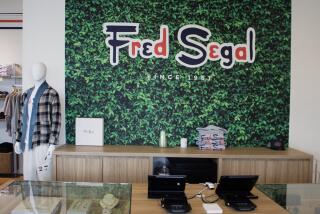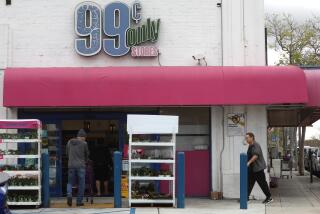Failed Firmsâ URLs Find Little Net Worth
As the pile of trashed dot-coms grows larger, investors in such companies as EToys are finding that thereâs usually little value to be squeezed from Web addresses and logos that they have spent heavily to promote.
EToys, which on Wednesday filed for Chapter 11 bankruptcy protection, has poured more than $125 million into advertising and marketing during the last two years. The firmâs troubles have sparked ongoing debate in Internet chat rooms on the likely value of the companyâs name. But the limited evidence associated with Internet failures suggests that investors wonât ease their financial pain by selling the name that was once one of e-tailingâs brightest stars.
âThe value of a [failed] dot-com name is directly related to the amount of brand equity built up, minus the damage done to the name during the shutdown process,â said Tim Miller, president of WebMergers.com, a company that matches Web-property buyers and sellers.
Miller acknowledged that his formula is âpretty nebulous,â but marketers agree that it underscores the challenge of retooling a once-hot domain name. But marketers who have plugged EToysâ domain name into Millerâs formula say the nameâs value has been hammered by media coverage of the companyâs problems.
âIâm not saying it canât be done, but how expensive will it be to re-educate consumers?â said Noah Manduke, Los Angeles-based managing director of Siegelgale, a corporate-identity firm. âHow much baggage EToys accumulated is also an issue. It is a brand, but what is it recognized for? Its online experience was anything but optimal for many consumers.â
With dot-com names now selling for cents on the dollar through U.S. bankruptcy courts, online executives are being forced to revisit Marketing 101 textbooks.
âA name alone is not a brand,â said Debby Goldberg, marketing director for Interbrand, a New York-based consulting firm. âMost of these [failed] companies werenât around long enough to build a relationship with consumers.â
Failed Pets.comâs $100-million advertising and marketing gambit featured a goofy sock puppet that merited network television talk show appearances and was invited to join the Macyâs Thanksgiving Day parade route. But, despite the popular advertising campaign, some consumers view Pets.com as the poster child for all that went wrong online.
Pets.comâs uniform resource locater, or URL, now redirects visitors to PetSmart.com--which offers them a first-time buyerâs discount. The Phoenix-based retailer acquired the heavily marketed Pets.com domain name even before the failed company announced it was closing its doors.
PetSmart Inc. wonât say what it paid for the URL, but company spokeswoman Lynne Adams described the sale as âa relatively small transaction, a nonmaterial event, really, for either company.â
PetSmart doesnât rule out an eventual reprise for Pets.com, but it wonât occur soon. âOur PetSmart brand is highly recognized,â Adams said. âAnd thatâs the benefit of having 535 stores--we are an established brand.â
A side note: The Pets.com sock puppet icon that proved to be a smash with consumers last year is still on the market.
The same story is being played out across the Internet. Failed Garden.com redirects visitors to Burpee Holding Co., the century-old seed company. Consumers who click on failed jeweler Miadora.comâs Web site are steered to Overstock.com, a liquidation firm that purchases the inventories of failed online companies.
Some online businesses are worth considerable money. Johnson & Johnson, for example, last week purchased the Baby Center Inc. Web site from EToys for $10 million. Visitors might not have known, but the San Francisco-based Web site had been a wholly owned subsidiary of troubled EToys. Johnson & Johnson already operates several Web sites that target parents of young children.
Overstock and other liquidation firms usually donât pay much for domain names.
âThe names have very little value to us,â said Overstock.com Vice President Kevin Lane. âWith Miadora, we wanted the inventory, and they offered the name along with it.â
When dot-coms tumble into bankruptcy, the domain names often end up on the auction block along with office furniture and excess inventory.
BigWords.com, a San Francisco-based college textbook retailer, spent an estimated $35 million to build brand awareness during its short life span. The companyâs name was sold through a U.S. Bankruptcy Court earlier this year for $34,000 to a former company executive, according to an attorney representing the U.S. Trusteeâs Office. In contrast, BigWordsâ excess inventory sold for about $1 million.
An executive at a Bay Area liquidation firm that is dismantling a defunct dot-com set the potential value of a used domain name at somewhere between âfive figures and zero.â But the executive linked the estimate to finding âa buyer in a related field that feels the URL is of value to him.â
That hasnât kept dot-com investors from trying to uncover hidden value in the failed names.
Microsoft Corp. co-founder Paul Allen and other investors are studying whether thereâs residual value in Mercata.com, the domain name of a failed e-tailer that spent an estimated $50 million to build brand awareness.
âWeâve gotten lots of inquiries from people who want to buy it, so weâre in the formal process right now of trying to figure out how to proceed,â said Mercata President and Chief Executive Tom Van Horn. âIt could be an international brand, with the Latin root and a meaning thatâs recognized in English, Spanish, French and Italian.â
Clues about the fate of failed online names might be found in the bricks-and-mortar world. Some brands--including White Cloud toilet paper, Oxydol laundry detergent and the Amiga computer operating system--are trying to prove that second acts are possible.
More often than not, however, when such famous names as Oldsmobile, Montgomery Ward and TWAs disappear, their brands usually donât reappear. âI donât think itâs going to be much different online,â Manduke said.
For every successful relaunch, there are the PanAms and Braniffs, long-standing businesses that fail to get back in the air or are grounded shortly after taking off. But optimists point to those brands that seem capable of using their reservoir of brand awareness to fuel a revival.
White Cloud bathroom tissue disappeared from grocery store shelves in 1993, when Procter & Gamble shifted its advertising dollars to market-leader Charmin. The abandoned brand found new life in 2000, when a Canadian paper company agreed to manufacture the brand for sale through Wal-Mart Stores Inc.
âWhite Cloud is still recognized as a premium brand by a majority of [older] shoppers,â said a marketing executive who is familiar with the brandâs reintroduction. âAnd, in marketing, thatâs the name of the game. You donât have to plow new ground.â
Entrepreneurs who late in 2000 bought the Oxydol name from P&G; are planning to reinvigorate advertising for the 87-year-old brand. Redox Brands Inc., located not far from P&G;âs headquarters, also picked up the Biz detergent line after P&G; focused on global market leader Tide.
Amiga Inc., the small, Snoqualmie, Wash.-based company that last year acquired domestic rights to the Amiga computerâs operating system, also is poised to attempt a brand revival. Amiga effectively disappeared from the U.S. market a decade ago, but the computer remains popular with Hollywood creative types.
Character Builders, a Columbus, Ohio-based animation studio, depends on aging Amiga machines to speed up the creative process. Apple has introduced more-powerful computers, but âsomehow the Amiga handles video far better than the latest and much more powerful Macs,â said Dan Root, an animation director with Character Builders. âThatâs unheard of in the technology world.â
Itâs also the kind of brand loyalty that Amiga President William McEwan is counting on to ease consumer acceptance of a next-generation Amiga software package tailored for Internet appliances, cellular phones and other digital devices.
âWeâve got hundreds of thousands of dedicated users out there,â McEwan said. âThe Amiga name is strong enough to get us past the initial hurdle and get consumers to take a look at us.â






